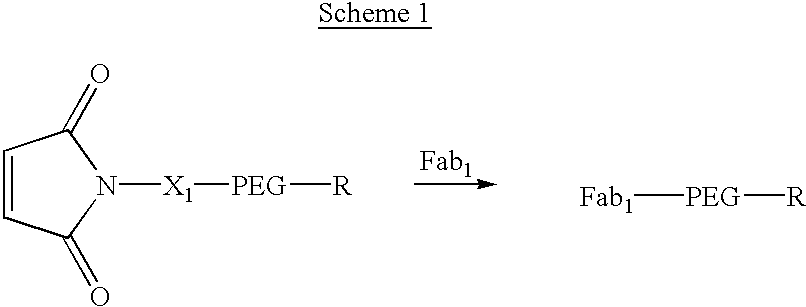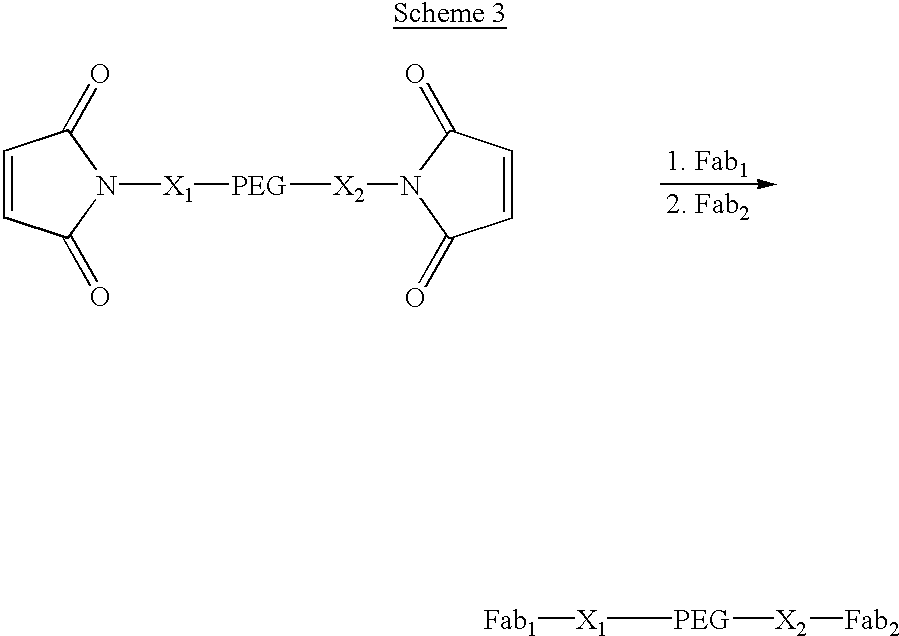Pseudo-antibody constructs
a technology of pseudo-antibody and construct, which is applied in the preparation of immunoglobulins against animals/humans, peptides, sugar derivatives, etc., can solve the problems of disadvantageous fc-mediated activity
- Summary
- Abstract
- Description
- Claims
- Application Information
AI Technical Summary
Benefits of technology
Problems solved by technology
Method used
Image
Examples
example 1
[0076] Construct 1, shown in scheme 1, illustrates the addition of a single Fab to a maleimido-PEG, where the molecular weight of the PEG is such that the construct has a longer in vivo half-life than Fab.sub.1, R can be an alkoxy group such as methoxyl or a compound selected from the structural categories of carbohydrates, saturated or unsaturated mono- or di-carboxylic acids, monoesters or amides of saturated or unsaturated di-carboxylic acids, higher alkoxy groups, lipids or other biologically compatible organic molecules. X.sub.1 is an optional linker or spacer between the maleimide moiety and the PEG. The preferred method of synthesis for these constructs is shown in Scheme 1, where the R group has been previously attached to the PEG; however, synthetic schemes can be envisioned where the R group is attached to the PEG after the Fab-maleimide reaction. Additional activity can be imparted to these constructs by the R group. 1
example 2
[0077] Construct 2, shown in Scheme 2, has identical Fabs on opposite ends of a PEG where the molecular weight of the PEG is such that the construct has a longer in vivo half-life than Fab.sub.1. X.sub.1 and X.sub.2 are linkers between the PEG and the maleimide groups and may be either structurally identical or structurally unique. This type of construct has the advantage over an IgG in that the two Fabs can bind to identical receptors that are significantly further apart than could be bridged by a conventional immnunoglobulin. 2
example 3
[0078] Construct 3, shown in Scheme 3, is composed of different Fabs on opposite ends of a PEG where the molecular weight of the PEG is such that the construct has a longer in vivo half-life than the Fabs from which it is constructed. This type of bifunctional .PSI. Ab construct has the advantage over a conventional bifunctional antibody fragment in that the two Fabs can bind to non-identical receptors that are significantly further apart than could be bridged by a conventional bifunctional construct. The synthesis of this type of construct is illustrated using sequential addition of the Fabs to a bis-maleimido-PEG, although other synthetic routes can be envisioned as well. This type of construct is well suited to a synthetic route in which the chemistry of attachment of the two Fabs is different, or the addition of one maleimide to the PEG is done after the addition of the first Fab. 3
PUM
| Property | Measurement | Unit |
|---|---|---|
| molecular weight | aaaaa | aaaaa |
| molecular weight | aaaaa | aaaaa |
| molecular weight | aaaaa | aaaaa |
Abstract
Description
Claims
Application Information
 Login to View More
Login to View More - R&D
- Intellectual Property
- Life Sciences
- Materials
- Tech Scout
- Unparalleled Data Quality
- Higher Quality Content
- 60% Fewer Hallucinations
Browse by: Latest US Patents, China's latest patents, Technical Efficacy Thesaurus, Application Domain, Technology Topic, Popular Technical Reports.
© 2025 PatSnap. All rights reserved.Legal|Privacy policy|Modern Slavery Act Transparency Statement|Sitemap|About US| Contact US: help@patsnap.com



